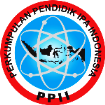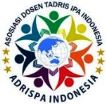Development of Learning Tools with the Means Ends Analysis Learning Model Based on Problem Solving in Newton's Law
Abstract
This study aims to produce a learning tool with the Means Ends Analysis (MEA) learning model based on problem solving in Newton's Law material for class X high school students. This research was conducted to improve problem solving abilities among students who were still low, especially on Newton material and the lack of learning tools used. The learning tools developed in this study consist of Learning Implementation Plans (RPP), Student work sheets (LKPD), and Assesment Instrument Tests. This type of research is Research and Development (R&D) with a 4D development model (Define, Design, Develop, and Disseminate). The research instruments used were lesson plans validation sheets, LKPD, and Cognitive Learning Outcomes Tests used by validators to assess learning tools. Data analysis in this study used descriptive analysis, by calculating the validity score of each learning device indicator. Based on the results of the validity analysis, the average value of lesson plan validity is 0.78. The average validity of LKPD is 0.75. The average validity of the Learning Outcomes Test Instrument is 0.802. The average validity of the overall device is 0.77, the learning tool for the MEA model based on problem solving in Newton's Law material is declared valid and suitable for use as a learning tool in Newton's Law material.
Keywords: learning tools, MEA, problem solving, newton’s law
Full Text:
PDFReferences
Asrizal, A., Ayu, D. F., Mardian, V., & Festiyed, F. (2022). Electronic Learning Material of Newton’s Laws with Kvisoft Flipbook Maker to Improve Learning Outcomes of Students. Jurnal Penelitian Pendidikan IPA, 8(2), 489–498. https://doi.org/10.29303/jppipa.v8i2.1222
Azizah, R., Yuliati, L., & Latifah, E. (2015). Kesulitan Pemecahan Masalah Fisika pada Siswa SMA. Jurnal Penelitian Fisika dan Aplikasinya (JPFA), 5(2), 44-50.
Bahtiar, B., Ibrahim, I., & Maimun, M. (2022). Profile of Student Problem Solving Skills Using Discovery Learning Model with Cognitive Conflict Approach. Jurnal Penelitian Pendidikan IPA, 8(3), 1340–1349. https://doi.org/10.29303/jppipa.v8i3.1657
Batlolona, J. R., Nenohai, A. J. W. T., Wenno, I. H., Wartono, & Yurdabakan, I. (2021). Merry go Round Technique and Students’ Physics Cognitive Learning Outcomes on Work and Energy Topic. Jurnal Pendidikan IPA Indonesia, 10(2), 178–186. https://doi.org/10.15294/jpii.v10i2.22964
Budiarso, A. S. (2017). Analisis Validitas Perangkat Pembelajaran Fisika Model Inkuiri Terbimbing untuk Meningkatkan Hasil Belajar Siswa SMA pada Materi Listrik Dinamis. Jurnal Edukasi, 4(2), 15. https://doi.org/10.19184/jukasi.v4i2.5204
Hasan, M., Mursalin, & Odja, A. H. (2021). Analysis of Student Problem Solving Skills On Physics Concepts in SMP/MTs Through Blended Learning Early Teaching During The Covid-19 Pandemic. Journal of Physics: Conference Series, 1876(1). https://doi.org/10.1088/1742-6596/1876/1/012081
Hertiavi, M. D., Langlang, H., & Khanafiyah, S. (2010). Penerapan Model Pembelajaran Kooperatif tTipe Jigsaw untuk Peningkatan Kemampuan Pemecahan Masalah Siswa SMP. Jurnal pendidikan Fisika Indonesia, 6(1). https://doi.org/10.15294/jpfi.v6i1.1104
Hidayah, T. L., Supeno, S., & Nuha, U. (2022). Pengaruh Model Inkuiri Terbimbing Menggunakan Laboratorium Virtual Terhadap Keterampilan Argumentasi Ilmiah Siswa SMP. EDUSAINTEK: Jurnal Pendidikan, Sains Dan Teknologi, 9(1), 239–250. https://doi.org/10.47668/edusaintek.v9i1.425
Hidayat, S. R., Setyadin, A. H., Hermawan, H., Kaniawati, I., Suhendi, E., Siahaan, P., & Samsudin, A. (2017). Pengembangan Instrumen Tes Keterampilan Pemecahan Masalah pada Materi Getaran, Gelombang, dan Bunyi. Jurnal Penelitian & Pengembangan Pendidikan Fisika, 3(2), 157–166. https://doi.org/10.21009/1.03206
Huda, M. (2013). Model-Model Pengajaran dan Pembelajaran (Cet. 5). Pustaka Pelajar.
Inriani, I., Azhar, A., & Nasir, M. (2021). Development of Learning Devices Using Creative Problem Solving (CPS) Models on Static Electricity Material. Jurnal Penelitian Pendidikan IPA, 7(SpecialIssue), 213–217. https://doi.org/10.29303/jppipa.v7ispecialissue.1119
Julius, R., Abd Halim, M. S., Abdul Hadi, N., Alias, A. N., Mohd Khalid, M. H., Mahfodz, Z., & Ramli, F. F. (2021). Bibliometric Analysis of Research in Mathematics Education using Scopus Database. Eurasia Journal of Mathematics, Science and Technology Education, 17(12), em2040. https://doi.org/10.29333/ejmste/11329
Mariani, Y., & Susanti, E. (2019). Kemampuan Pemecahan Masalah Siswa Menggunakan Model Pembelajaran MEA (Means Ends Analysis). Lentera Sriwijaya : Jurnal Ilmiah Pendidikan Matematika, 1(1), 13–26. https://doi.org/10.36706/jls.v1i1.9566
Nurcahyo, A. W., Wartono, W., & Yuliati, L. (2017). Kemampuan Pemecahan Masalah Hukum Gerak Newton Mahasiswa melalui Pembelajaran Cooperative Problem Solving. Jurnal Pendidikan: Teori, Penelitian, dan Pengembangan, 2(7), 963-970. https://doi.org/10.17977/jptpp.v2i7.9686
Pasigon, C. P. (2022). Attributes Of Students Towards Problem Solving In Physics: A Step Towards Students’ Capacity Building. Journal of Positive School Psychology, 6(10), 531–544.
Puspita, A. D., Islami, N., Nasir, M., & Fakhruddin. (2020). Development of Interactive Learning Media Based on HOTS Material Temperature and Heat. Journal of Physics: Conference Series, 1655(1), 1–6. https://doi.org/10.1088/1742-6596/1655/1/012011
Rahman, A. A. (2017). Pengembangan Perangkat Pembelajaran Berbasis Pendekatan Realistik Untuk Meningkatkan Kemampuan Pemecahan Masalah Matematis Siswa SMP N 3 LANGSA. MAJU : Jurnal Ilmiah Pendidikan Matematika, 4(1).
Riana, A. A. (2017). Application of Means Ends Analysis (MEA) Learning Model in Attempt to Improve Student’s High Order Thinking. International Journal Pedagogy of Social Studies, 2(1), 145. https://doi.org/10.17509/ijposs.v2i1.8688
Setyani, N. D., Cari, C., Suparmi, S., & Handhika, J. (2017). Student’s Concept Ability of Newton’s Law Based on Verbal and Visual Test. International Journal of Science and Applied Science: Conference Series, 1(2), 162. https://doi.org/10.20961/ijsascs.v1i2.5144
Simanungkalit, R. H. (2016). Pengembangan Perangkat Pembelajaran untuk Meningkatkan Kemampuan Pemecahan Masalah Matematis Siswa SMP Negeri 12 Pematangsiantar. MUST: Journal of Mathematics Education, Science and Technology, 1(1), 39. https://doi.org/10.30651/must.v1i1.96
Supeno, S., Subiki, S., & Rohma, L. W. (2018). Students’ Ability In Solving Physics Problems on Newtons’ Law of Motion. Jurnal Ilmiah Pendidikan Fisika Al-Biruni, 7(1), 59–70. https://doi.org/10.24042/jipfalbiruni.v7i1.2247
Susiana, N., Yuliati, L., & Latifah, E. (2017). Analisis Pembelajaran Berdasarkan Profil Kemampuan Pemecahan Masalah Fisika Siswa Kelas X SMA. Biologi, Pembelajaran, Dan Lingkungan Hidup Perspektif Interdisipliner, 3(1), 210–214.
Thiagarajan, S. (1974). Instructional development for training teachers of exceptional children: A sourcebook.
Wardani, K. E. K., Djudin, T., & Mursyid, S. (2021). Pengaruh Model Cooperative Problem Solving Terhadap Kemampuan Pemecahan Masalah Siswa pada Materi Tekanan. Jurnal Inovasi Penelitian dan Pembelajaran Fisika, 2(1), 36. https://doi.org/10.26418/jippf.v2i1.42453
Wicaksono, I., Jatmiko, B., & Prastowo, T. (2017). Pengembangan Perangkat Pembelajaran Fisika Model Learning Cycle 5e untuk Meningkatkan Pemahaman Konsep Siswa pada Materi Fluida Statis. JPPS (Jurnal Penelitian Pendidikan Sains), 4(2), 518. https://doi.org/10.26740/jpps.v4n2.p518-524
Zahroh, S. H., Parno, P., & Mufti, N. (2018). Keterampilan Pemecahan Masalah dengan Model Search, Solve, Create, and Share (SSCS) Problem Solving Disertai Conceptual Problem Solving (CPS) pada Materi Hukum Newton. Jurnal Pendidikan: Teori, Penelitian, dan Pengembangan, 3(7), 968-973.
Zulkifli, Z., Azhar, A., & Syaflita, D. (2022). Application Effect of PhET Virtual Laboratory and Real Laboratory on the Learning Outcomes of Class XI Students on Elasticity and Hooke’s Law. Jurnal Penelitian Pendidikan IPA, 8(1), 401–407. https://doi.org/10.29303/jppipa.v8i1.1274
DOI: http://dx.doi.org/10.24014/jnsi.v5i2.14894
Refbacks
- There are currently no refbacks.

Journal of Natural Science and Integration
E-ISSN: 2620-5092 P-ISSN: 2620-4967
Published By:
Department of Science Education, Faculty of Education and Teacher Training,
State Islamic University of Sultan Syarif Kasim Riau, Indonesia
Mailing Address:
Jl. H.R Soebrantas Km. 15 No. 155
Kelurahan Simpang Baru
Kecamatan Tuah Madani, Pekanbaru, Riau, Indonesia
Email: jnsi.tadrisipa@uin-suska.ac.id
Indexed By:
Journal of Natural Science and Integration is licensed under a Creative Commons Attribution 4.0 International License.


_-_Copyy2.png)






.jpg)
.png)
.jpg)
.jpg)




